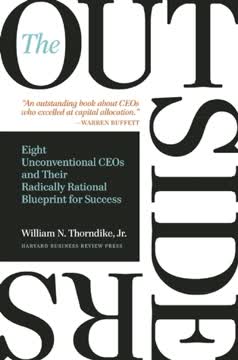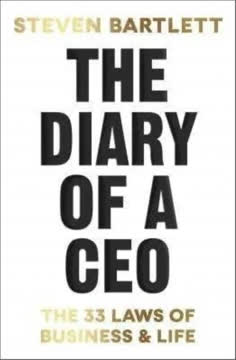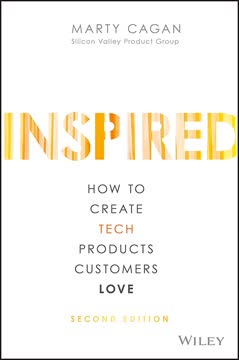Key Takeaways
1. Embrace uncertainty as the wellspring of opportunity
"Uncertainty is not the frightening prospect we believe it to be. Instead it gives us the freedom to choose our own path. If the future is unwritten, we can be the ones to write it."
Uncertainty is inevitable. Our world is inherently unpredictable, with complex systems, human behavior, and technological advancements constantly interacting in unforeseen ways. This unpredictability extends to all aspects of life, including business, where even the most carefully laid plans can be upended by unforeseen events.
Opportunity in chaos. Rather than fearing uncertainty, we should recognize it as the source of our greatest opportunities. In a perfectly predictable world, there would be no room for innovation, creativity, or competitive advantage. It is precisely because the future is uncertain that we have the freedom to shape it.
Practical implications:
- Embrace change and adaptability in your business strategy
- Look for opportunities in disruptions and market shifts
- Cultivate a mindset that sees possibilities rather than obstacles in uncertain situations
2. Adopt a probabilistic mindset to navigate unpredictability
"Everything in business is a numbers game."
Shift from deterministic to probabilistic thinking. Traditional management approaches often assume a level of certainty and control that simply doesn't exist in reality. Instead, we must adopt a probabilistic mindset that acknowledges the role of chance and focuses on improving our odds of success.
Key probabilistic strategies:
- Focus on affordable loss rather than expected returns
- Increase the number of opportunities you pursue (broaden the top of your funnel)
- Optimize your conversion rate (improve what goes in at the top to what comes out at the bottom)
- Be willing to take calculated risks with the potential for non-linear payoffs
Practical applications:
- Set learning goals rather than rigid performance targets
- Experiment with multiple approaches simultaneously
- Be prepared to pivot or abandon ideas that aren't working
- Celebrate and learn from failures as well as successes
3. Cultivate a growth mindset and healthy relationship with failure
"We cannot succeed if we don't try."
Embrace growth and learning. Adopt Carol Dweck's growth mindset – the belief that our abilities can be developed through dedication and hard work. This mindset is crucial for thriving in uncertainty, as it allows us to see challenges as opportunities for growth rather than insurmountable obstacles.
Reframe failure. Understand that in an uncertain world, great decisions don't always lead to great outcomes. Failure is not a reflection of your worth or abilities, but an inevitable part of the learning process.
Key principles for developing resilience:
- Focus on the process and learning, not just outcomes
- Set realistic expectations and prepare for setbacks
- Create routines and rituals to maintain focus and motivation
- Seek feedback and be open to constructive criticism
- Practice self-compassion and avoid negative self-talk
4. Build social capital through genuine relationships and networking
"Be a host in life, not a guest."
Invest in relationships. In an unpredictable world, your network becomes your greatest asset. Cultivate genuine relationships without expectation of immediate return, and treat every interaction as a potential long-term investment.
Key networking strategies:
- Be helpful and generous with your time and knowledge
- Connect people who might benefit from knowing each other
- Share your passions and interests, not just your job title
- Follow up and nurture relationships over time
- Guard your reputation carefully
Practical tips:
- Attend industry events and join professional organizations
- Engage actively on social media platforms
- Offer to mentor or be mentored
- Practice active listening and empathy in conversations
- Look for opportunities to add value to others' lives and work
5. Master the art of selling to turn opportunities into outcomes
"Selling is the process of identifying a person's problems or needs, determining and presenting the most valuable solutions to them, and securing commitment to a course of action."
Selling is essential. Whether you're an entrepreneur, employee, or leader, the ability to sell ideas, products, or yourself is crucial for success. Effective selling is about creating value for others, not manipulation or pressure tactics.
Key components of effective selling:
- Prospecting: Identify potential customers or opportunities
- Investigating: Understand the customer's needs and problems
- Presenting: Offer solutions that address those needs
- Negotiating: Reach mutually beneficial agreements
Practical selling tips:
- Focus on the customer's needs, not your product features
- Ask thoughtful questions and practice active listening
- Use concrete, vivid language in your presentations
- Be prepared to handle objections and negotiate effectively
- Follow up consistently and build long-term relationships
6. Apply entrepreneurial methods to thrive in uncertain environments
"Expert entrepreneurs typically don't start out with revenue or sales targets, or commit to an inflexible vision of the future. They focus on getting feedback from the market as early and cheaply as possible, and assembling a high-performance team that can solve unexpected, complex problems in short order."
Think like an entrepreneur. Adopt entrepreneurial methods that are better suited to navigating uncertainty than traditional management approaches. These methods focus on learning, adaptability, and creating value in the face of unknown outcomes.
Key entrepreneurial principles:
- Work from the basis of affordable loss, not expected returns
- Start selling and getting feedback as early as possible
- Build real prototypes quickly rather than relying on elaborate plans
- Remain flexible and willing to pivot based on market feedback
- Focus on timing and creating value, not just unique features
Practical steps:
- Develop a minimum viable product (MVP) to test your ideas
- Use lean startup methodologies to iterate quickly
- Seek out diverse perspectives and expert feedback
- Be willing to abandon ideas that aren't gaining traction
- Celebrate learning and progress, not just financial success
7. Pursue growth through customer acquisition and continuous improvement
"Brands grow primarily through acquiring more customers, not through deepening loyalty."
Focus on acquisition. While customer retention is important, research shows that brands grow primarily by acquiring new customers rather than increasing loyalty among existing ones. This insight should guide your growth strategies.
Key growth strategies:
- Prioritize revenue growth over cost reduction
- Proactively manage pricing to maximize value
- Increase mental availability through reach, relevance, and recognition
- Improve buyability by expanding channels and reducing purchase barriers
- Continuously improve products, services, and customer experiences
- Balance exploitation of existing opportunities with exploration of new ones
Practical growth tactics:
- Invest in marketing and advertising to reach new customers
- Simplify the purchase process and reduce adoption barriers
- Expand your product range to meet more customer needs
- Regularly review and optimize pricing strategies
- Allocate resources for both incremental improvements and breakthrough innovations
8. Foster a culture of adaptability, psychological safety, and diversity
"Create a culture in which it is okay to make mistakes and unacceptable not to learn from them."
Culture is crucial. The ability to thrive in uncertainty depends heavily on organizational culture. Foster an environment that encourages learning, experimentation, and diverse perspectives.
Key cultural elements:
- Psychological safety: Create an environment where people feel safe to take risks and be vulnerable
- Positive error culture: Treat mistakes as learning opportunities, not causes for punishment
- Diversity and inclusion: Embrace both demographic and cognitive diversity to enhance problem-solving and innovation
- Adaptability: Maintain the flexibility to respond quickly to changing circumstances
Practical steps to improve culture:
- Lead by example in admitting mistakes and seeking feedback
- Encourage and reward learning and experimentation
- Implement diverse hiring practices and inclusive policies
- Create cross-functional teams to break down silos
- Regularly reassess and adjust organizational structures and processes
- Provide opportunities for continuous learning and skill development
Last updated:
FAQ
What's Mastering Uncertainty about?
- Focus on Unpredictability: Mastering Uncertainty by Matt Watkinson and Csaba Konkoly explores how successful leaders thrive in an unpredictable world, emphasizing that uncertainty is a fundamental aspect of life and business.
- Embracing Chance: The book argues for embracing uncertainty as a source of opportunity, offering practical techniques for decision-making in a world where outcomes are often beyond control.
- Three-Part Structure: It is divided into three parts: understanding chance, creating luck, and managing organizations that thrive on uncertainty, providing a comprehensive guide to mastering unpredictability.
Why should I read Mastering Uncertainty?
- Practical Guidance: The book offers actionable insights and strategies for dealing with uncertainty, essential for success in business or personal endeavors.
- Real-World Applications: It includes real-life examples and case studies that illustrate how embracing uncertainty can lead to unexpected opportunities, making concepts relatable and applicable.
- Mindset Shift: Reading it can fundamentally change your perspective on uncertainty, helping you view it as a source of potential rather than a barrier, crucial for growth.
What are the key takeaways of Mastering Uncertainty?
- Embrace Uncertainty: Uncertainty should be embraced as a source of opportunity, with the authors arguing that "without uncertainty, there wouldn’t be opportunity."
- Probabilistic Thinking: The book emphasizes thinking probabilistically rather than deterministically, allowing for better decision-making in uncertain situations.
- Social Capital: Building relationships and social capital is crucial for creating opportunities, with more interactions leading to more possibilities.
What is the gap selling method mentioned in Mastering Uncertainty?
- Identifying the Gap: The method focuses on identifying the gap between a customer's current state and their desired future state, essential for effective selling.
- Perception of Value: Salespeople must help prospects appreciate the significance of the gap, involving insightful questions and valuable insights.
- Change is Constant: Acknowledges that change is constant in sales, with trust and credibility being vital for customers to feel comfortable with proposed changes.
What is the affordable loss principle in Mastering Uncertainty?
- Definition of Affordable Loss: It refers to the maximum resources one is willing to risk in pursuit of a new idea, focusing on manageable risks rather than potential returns.
- Risk Management: This principle allows entrepreneurs to make informed decisions without overextending, fostering experimentation while minimizing negative impacts.
- Encourages Innovation: By limiting losses, it creates a safe space for creativity and exploration, encouraging teams to explore new ideas.
How does Mastering Uncertainty define social capital?
- Foundation of Opportunity: Social capital is described as the foundation of opportunity in an uncertain world, referring to relationships and networks that lead to unexpected opportunities.
- Long-Term Relationships: Emphasizes treating relationships as long-term investments, with trust and generosity enhancing social capital.
- Costly Signaling: Introduces costly signaling, where individuals demonstrate trustworthiness through actions imposing costs on themselves, building credibility.
What are the five attitudinal principles for thriving in uncertainty according to Mastering Uncertainty?
- Healthy Relationship with Failure: Viewing setbacks as learning opportunities rather than personal shortcomings reduces the fear of failure.
- Growth Mindset: Believing abilities can be developed through effort encourages embracing challenges and persisting despite difficulties.
- Tenacity: Emphasizes perseverance in achieving success, with those who keep trying more likely to reach their goals.
What is the significance of cognitive diversity in organizations according to Mastering Uncertainty?
- Enhanced Problem-Solving: Cognitive diversity brings different perspectives, leading to more innovative solutions for complex challenges.
- Avoiding Groupthink: Diverse teams are less likely to fall into groupthink, fostering a dynamic and effective team environment.
- Link to Psychological Safety: Most effective when paired with psychological safety, allowing team members to share insights without fear of judgment.
How does Mastering Uncertainty define psychological safety?
- Definition of Psychological Safety: Described as the degree to which team members feel safe to take risks and be vulnerable, crucial for open communication.
- Impact on Performance: Teams with high psychological safety perform better, as members feel comfortable sharing ideas and admitting mistakes.
- Four Stages of Safety: Outlines four stages: inclusion safety, learner safety, contributor safety, and challenger safety, enhancing team dynamics.
What role does tenacity play in achieving success according to Mastering Uncertainty?
- Persistence is Key: Tenacity involves the ability to keep going despite setbacks, crucial for achieving goals.
- Learning from Setbacks: Setbacks and failures are inevitable, and learning from them equips individuals for future success.
- Real-Life Examples: Provides examples of successful individuals like J.K. Rowling and James Dyson, illustrating that persistence leads to extraordinary outcomes.
What are some practical techniques for creating your own luck according to Mastering Uncertainty?
- Increase Interactions: Increasing interactions with others raises the chance of serendipitous encounters leading to opportunities.
- Be a Host: Adopting a host mentality by helping others without expecting returns fosters goodwill and reciprocal benefits.
- Share Your Passions: Mentioning passions alongside professional roles creates common ground and makes you more memorable.
What are the best quotes from Mastering Uncertainty and what do they mean?
- "Without uncertainty, there wouldn’t be opportunity.": Encapsulates the theme that uncertainty is a source of potential, not a barrier.
- "The best way to build momentum is by building momentum.": Emphasizes taking action and making progress, even with small steps.
- "You miss one hundred percent of the shots you don’t take.": Attributed to Wayne Gretzky, reinforcing that taking risks is essential for success.
Review Summary
Mastering Uncertainty receives mixed reviews, with an average rating of 3.83 out of 5. Some readers find it insightful and valuable for business management, praising its no-nonsense approach to dealing with uncertainty. Others feel it rehashes familiar concepts and focuses too heavily on business rather than personal growth. Positive reviews highlight the book's wisdom and practical advice, while critical reviews mention a lack of novelty and limited applicability outside the business world. Overall, opinions vary on its usefulness and relevance to different readers' interests.
Similar Books










Download PDF
Download EPUB
.epub digital book format is ideal for reading ebooks on phones, tablets, and e-readers.





